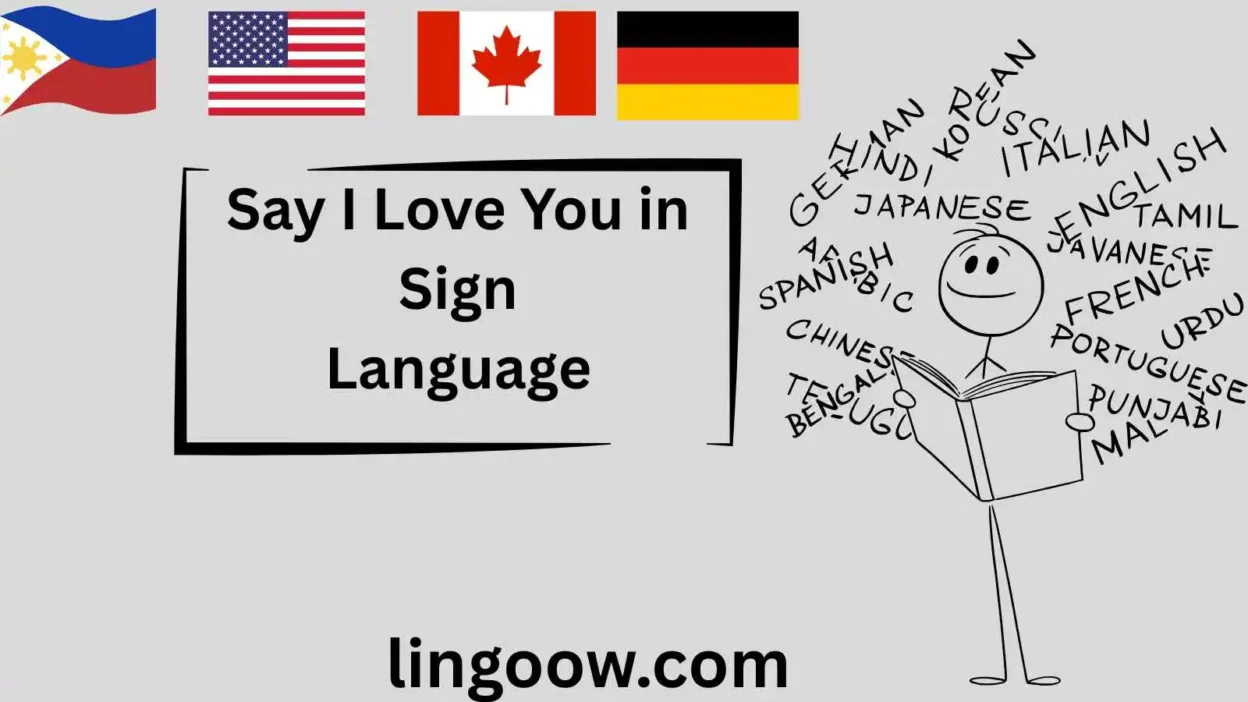Have you ever watched someone sign I love you from across a crowded room and felt your heart skip? I have.
It was at a family wedding—my cousin, who is deaf, signed it to his bride during their vows. No sound, just the gentle sweep of his hand: thumb, index, and pinky extended like a quiet promise.
In that moment, the entire hall fell silent, not out of awkwardness, but reverence. That single gesture carried more weight than a thousand spoken words.
Sign language isn’t just communication—it’s emotion made visible. And while spoken “I love you” changes with every tongue, the signed version carries the same heartbeat across continents, cultures, and histories. This isn’t about words. It’s about how we show what words often fail to say.
Quick Reference Table
| Sign Language | How It’s Signed | Cultural Insight |
| American Sign Language (ASL) | Extend thumb, index, and pinky (ILY handshape), palm out. | Iconic in Deaf culture; used casually among friends, family, and even in pop culture (think rock concerts). |
| British Sign Language (BSL) | Point to self → cross fists over chest → point to other. | Reflects British emotional reserve—direct but heartfelt, often with a warm smile. |
| French Sign Language (LSF) | Form a small heart with thumbs and index fingers touching. | Ties into France’s romantic identity; poetic and visually tender. |
| German Sign Language (DGS) | Point to self → hands flat on chest, circle gently → point to other. | Precise and grounded, mirroring German directness in emotion. |
| Spanish Sign Language (LSE) | Heart shape or cross arms over chest with passion. | Expressive facial cues amplify intensity—love here is felt. |
| Italian Sign Language (LIS) | Tap chest twice with fist → point to person. | Dramatic and warm, like an Italian embrace without touch. |
| Japanese Sign Language (JSL) | Point to self → form heart over chest → point to other. | Subtle yet sincere; aligns with Japan’s understated affection. |
| Korean Sign Language (KSL) | Cross arms over chest in an “X” → point to person. | Rooted in han (deep emotion); quiet but powerful. |
| Chinese Sign Language (CSL) | Point to self → hands form heart → point outward. | Visual harmony reflects cultural emphasis on balance and connection. |
| Auslan (Australian Sign Language) | ILY handshape (same as ASL), palm out. | Casual and friendly—used widely in schools and families. |
| Indian Sign Language (ISL) | Point to self → place hand on heart → extend to other. | Deeply tied to Bollywood romance and familial devotion. |
| Brazilian Sign Language (Libras) | Form heart with hands → point to person. | Joyful and animated—love is celebrated, not whispered. |
| South African Sign Language (SASL) | Cross arms over chest → point to person. | Rooted in ubuntu—love as collective care and humanity. |
| Langue des Signes Québécoise (LSQ) | Similar to LSF heart, but with softer motion. | French-Canadian warmth with a gentle, flowing style. |
| Russian Sign Language (RSL) | Point to self → hand on heart → sweep toward person. | Soulful and dramatic, echoing Russian literary passion. |
European Sign Languages
In France (LSF), love is a heart drawn in air—two hands shaping a delicate symbol, like sketching romance on an invisible canvas. It’s no surprise in a country that gave us je t’aime and candlelit confessions.
Cross the border to Germany (DGS), and the sign becomes structured: circles on the chest, like turning a key in the heart. Germans value clarity—even in love, there’s order.
In Italy (LIS), it’s a double tap to the chest—ti amo with rhythm, like a heartbeat you can see. Italians don’t just say love; they perform it.
Spain (LSE) adds fire—eyes wide, brows raised, the heart sign pulsing with drama. Here, love isn’t shy. It’s a flamenco of the hands.
And in Britain (BSL), it’s a quiet sequence: me, love, you. Reserved on the surface, but the crossed fists over the chest? That’s pure devotion.
Asian Sign Languages
In Japan (JSL), the heart gesture is small, almost hidden—love is private, precious, not shouted. It mirrors aishiteru, rarely spoken aloud.
Korea (KSL) uses an “X” over the chest—simple, strong, like a vow sealed in silence. It carries saranghae, but with the weight of endurance.
In China (CSL), the heart is centered, balanced—love as harmony between two souls. It reflects Confucian ideals of connection and duty.
India (ISL) places a hand on the heart before extending it outward—like offering your entire being. In a land of arranged marriages and epic romances, this sign bridges tradition and passion.
African Sign Languages
In South Africa (SASL), the crossed arms aren’t just personal—they’re communal. Love here is ubuntu: I am because we are.
Swahili-influenced East African signing (Kenya, Tanzania) often uses a sweeping motion from heart to person—like sending love on a journey.
In Nigeria (NSL variations), love signs may include a gentle head nod—respect and affection intertwined.
Across the continent, love in sign language often involves the whole body—shoulders, face, posture—because in many African cultures, emotion is never just in the hands.
Indigenous & Island Sign Languages
Maori Sign Language (NZSL influence) uses a pressing motion to the chest—aroha as a force that binds whānau (family).
Cherokee communities use a gesture from heart to sky—love as a sacred gift from the Creator.
In Samoa, the sign may include a soft clap or touch—love as celebration, as sharing, as alofa.
These languages remind us: love isn’t just between two people. It’s between people and place, ancestors and future.
Cultural Insights
The ILY handshape (ASL) wasn’t always universal—it exploded in the 1970s thanks to Deaf President Now and pop culture. Today, hearing people flash it at concerts, unaware of its Deaf roots.
Religious contexts matter too: in Islamic signing communities, love for Allah may use upward-pointing hands; in Christian ones, a cross-over-heart motion.
And in war zones, sign language has saved lives—lovers separated by conflict, reuniting with a single silent I love you.
Proverbs & Sayings About Love in Silence
- Italy: “Amore non è guardato, è sentito.” (Love is not looked at, it is felt.)
- Hawaii: “Aloha is given freely, like the wind.”
- India: “Dil se dil tak, haath ka safar.” (From heart to heart, a journey of the hand.)
FAQs
Why do some sign languages use the same “heart” shape?
The heart is a universal symbol—easy to form, instantly recognizable. It’s visual shorthand for an emotion we all share.
What’s the oldest known sign for love?
Love was often a hand-to-heart gesture.
Can hearing people use sign language to say “I love you”?
Absolutely. Just learn respectfully—context and intent matter.
Why don’t all sign languages have one universal “I love you”?
Final Thought
Whether it’s a bold ILY in New York, a gentle heart in Paris, or a sweeping motion under African skies—one truth remains: love needs no sound to be heard.
So here’s your challenge:
Learn one sign for “I love you” in a language not your own. Use it. Share it.
Tag a friend. Teach your family. Post it with #SilentLove.
How do you say “I love you” in sign language? Drop your story, your language, your moment below. Let’s build a global gallery of silent love. 💛




